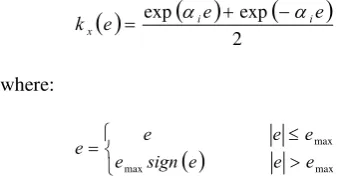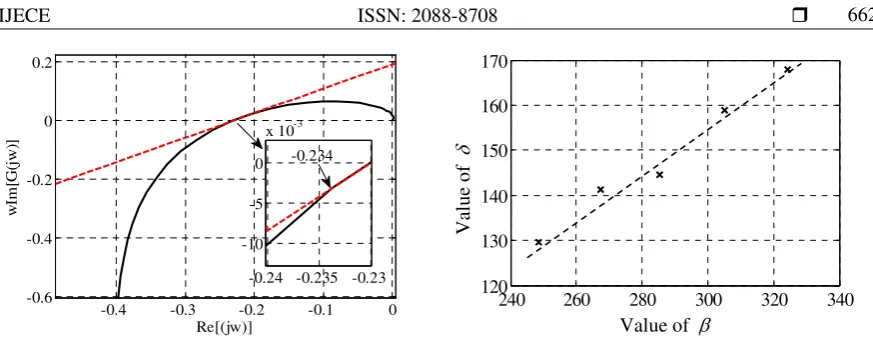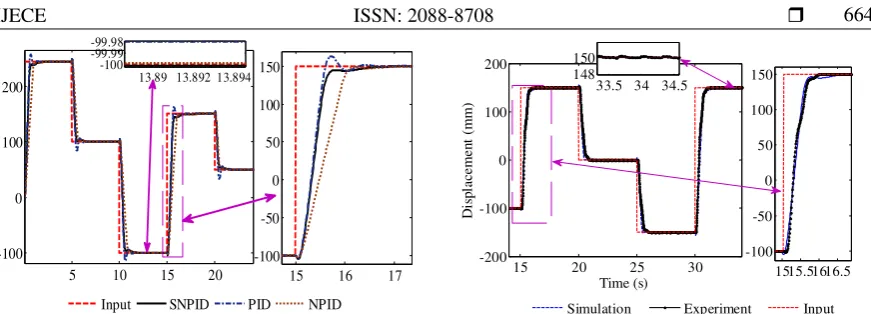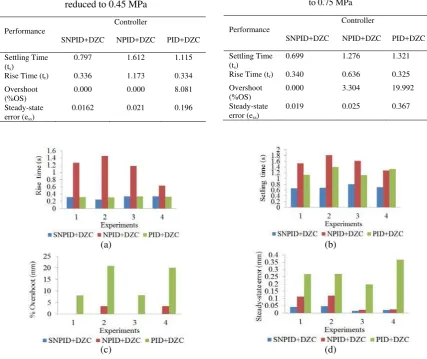ISSN: 2088-8708 658
Robust Control Strategy for Pneumatic Drive System via
Enhanced Nonlinear PID Controller
Sy Najib Sy Salim1, MF Rahmat2, AAM Faudzi3, ZH Ismail3, NH Sunar2, Shamsul Anuar Samsudin4
1
Department of Control, Instrumentation and Automation, Faculty of Elect. Eng, Univ Teknikal Malaysia Melaka
2
Department of Control and Mechatronic Engineering, Faculty of Elect. Eng, Universiti Teknologi Malaysia
3
Centre for Artificial Intelligence & Robotics (CAIRO), Universiti Teknologi Malaysia, Kuala Lumpur, Malaysia
Article Info ABSTRACT
Article history:
Received Jun 22, 2014 Revised Aug 24, 2014 Accepted Sep 10, 2014
This paper presents the pneumatic positioning system controlled by Enhanced Nonlinear PID (NPID) controller. The characteristic of rate variation of the nonlinear gain that are readily available in NPID controller is utilized to improve the performance of the controller. A Self-regulation Nonlinear Function (SNF) is used to reprocess the error signals with the purpose of continuously generating the values for the rate variation. Subsequently, the controller has successfully been implemented on dynamically changing loads and pressures. The comparison with the other available method such as. NPID and conventional PID are performed and evaluated. The effectiveness of this method with Dead Zone Compensator (DZC) has also been successfully demonstrated and proven through simulations and experimental studies.
Keyword:
pneumatic positioning system NPID
SNF
dead-zone compensation
robustness Copyright © 2014 Institute of Advanced Engineering and Science.
All rights reserved.
Corresponding Author:
M.F. Rahmat,
Department of Control and Mechatronic Engineering,
Faculty of Electrical Engineering, Universiti Teknologi Malaysia. Email: [email protected]
1. INTRODUCTION
Pneumatic actuators are widely used in industries to perform many tasks such as pick and place application, gripping, clamping, drilling and spraying. They are categorized under fluid power control and apply the principles of using compressed gas as a source of power to perform a variety of tasks. It deals with mechanical properties of gases and offer several advantages such as simple to maintain, fast motion, low cost, high power to weight ratio, free from overheating and reliable [1]. The ability to operate at a high number of cycles per workday is also one of the advantages of this drive. Due to these advantages, it has been promoted as an alternative to hydraulics and electric servo motors in many automated tasks. In spite of these advantages, pneumatic actuators are subject to nonlinearities due to compressibility of air, high friction forces and dead band of the spool movement in the valve [2]. These nonlinearities make an accurate position difficult to achieve, and it requires an appropriate controller for better performance.
ISSN: 2088-8708
applied on the early of 2000s. However, in the last decade many researchers found that the techniques that integrate with PID controller are more practical. It referred to the increasing number of publications written by [13-21] amongst others. For example, due to the drawback of adaptive controllers that are not fast enough to follow the parameter variation, [16] have proposed Multi-model controller based on several fixed PD-controllers. This technique is proposed for the position control of a pneumatic cylinder under variable loads. Five PD controllers were tuned based on the estimated model for the five fixed load that has been identified earlier. Experimental results show that this technique significantly improved the ability of producing a good performance even under variable load conditions.
This paper deals with the investigation on the robustness of the pneumatic actuators which controlled by the novel Self-regulation Nonlinear PID (SNPID) controller that had been published in the previous work [22]. The system is examined based on the variation of load and pressure in increasing and decreasing values. The DZC was added to the real system, and the consequence to the system was observed. The experiments were performed to confirm the capability of this controller. The comparisons with the other existing methods including PID and NPID controller are performed based on transient and steady-state performance. The rest of this paper is organized as follows: In section 2, research method is described starting with mathematical modelling and followed by the design of the controller. The simulated and experimental results using MATLAB/SIMULINK are described in section 3. Finally, section 4 contains some concluding remarks.
2. RESEARCH METHOD 2.1 System Model
The system under consideration is shown in Fig.1. It consists of 5/3 proportional directional control valve, double-acting with double rod cylinder, displacement transducer, pressure sensors, data acquisition system, PC and mass payload. The transfer function of the system is obtained using System Identification. For this purpose, 2000 data points representing the input and output signal of the open loop system were collected with a sampling time of 0.01 second. A state space model as shown in (1) and (2) is used as a model structure of the system.
) and KRn×m represent the state-vector, measured output, measured input signal and noise, respectively. The estimation of the values of the parameters is performed using the Prediction-Error Minimization (PEM) technique within MATLAB. Through this method, the parameters are calculated by minimizing a cost function of the prediction errors, (t) giving;
where ZN and N denotes the set of data and number of data samples, respectively. For example, the input-output data over a time interval of 1 is represented by:
)]
The data is used for estimating a model. The difference between the observed output and predicting output is known as the residual or prediction error which is given by
)
The estimated parameter is obtained by minimizing (3) as follows;
N
The following equation is the discrete state-space equation obtained through this identification process.
The continuous transfer function can be obtained using the Zero Order Hold (ZOH) conversion method with sampling time, Ts = 0.01s. This conversion method generates the continuous time input signal by holding each sample value constant over one sample period.
Figure 1. Experimental Setup Figure 2.System with SNPID controller
a. Controller Design
In general, the transfer function of PID controller with noise filter is given by:
where Kp is the proportional gain and Ti is the integral time. Both parameters can be tuned to improve the rise time and eliminate the steady state error, respectively. Meanwhile, the derivative time, Tdcan give the effect of increasing the stability of the system by improving the transient response. In control system design, stability is the first criterion that needs to be considered. In order to maintain the stability of the system, the conditions as written in (9) must be complied.
j BT
1L (9)
where is a magnitude of the open loop system.
ISSN: 2088-8708
design should correspond to various criteria including gain margin, phase margin, gain crossover frequency and maximum sensitivity. In order to ensure the optimum performance to be acquired, several simulations based on different Gain Margin (GM) and Phase Margin (PM) were conducted as depicted in Table 1. Based on these results, the optimum value of GM and PM are 15.7 dB and 71.9 at frequency 1.380 Hz and 0.286 Hz, respectively. These values provide an appropriate trade-off between speed performance and robustness. According to [23], in practice for well-tuned system the value of GM and PM should be between 6 dB to 20 dB and 35 to 80, respectively. The maximum peak for the sensitivity function is less than 6dB.
Table 1. Performance of the System with respect to GM and PM
Gm Pm tr (s) ts (s) Number of oscillation Robustness criterion
2.3. Determination of Nonlinear Gain
The nonlinear gain, kx(e) which bounded in the sector 0kx
e kemax as indicated in (10) is usedto increases the performance of the system in terms of speed. This gain represents the continuous dynamic nonlinear function. This function is then combined in cascade with PID controller.
αiand emax represent the rate variation of nonlinear gain and range of variation, respectively. The value of nonlinear gain kx(e) is automatically varied depends on the value of αi that is on-line generated using (11). Figure 2 shows the block diagram of the system with SNPID controller.
Figure 3. Popov plot Figure 4. Relationship between and
Subsequently, the design parameters are determined by identifying the relationships between and
in order to produce the maximum value of rate variation (αi) with exponential decay. It performed using Particle Swarm Optimization (PSO) technique. Details on this technique were explained in [22]. Table 2 indicates the results of and through this optimization technique. The relationships between and can be plotted as shown in Figure 4. Thus, the equation as expressed in (13) can then be applied to determine the value of and .
0.519 (13)
Table 2. Parameter determination via Particle Swarm Optimization Parameter Opt 1 Opt 2 Opt 3 Opt 4 Opt 5
167.902 141.202 158.904 144.502 129.510
324.411 267.513 305.211 285.301 248.531
: 0.518 0.528 0.521 0.506 0.521
The rate variation (αi) is designed to provide a certain value of nonlinear gain at the beginning for the purpose to overcome the static friction. This rate variation is then decreasing starting from this value and ending at 0 where the steady state response is achieved. For better interpretation, it can be elaborated through the following derivation. From (11), let;
Considered impulse response represents the error signal, thus;
( )
1 exp ()Perform differential of (14);
()
exp ()Based on the initial value theorem;
2
240 260 280 300 320 340
ISSN: 2088-8708
0 exp lim ) (
lim 2
t
t
t t
(17)
2.4. Dead-zone Compensation
In practice, the width of dead-zone is unknown. Thus, the DZC is employed to offset the deleterious effects of dead-zone. A similar compensator as in [22] is used to overcome this problem. It is implemented by using the following rules:
0
e DZC
d thenU U
e e
if
P DZC
dAndU then U u
e e
if 0
n DZC
dAndU thenU u
e e
if 0
where Ue0 , up and un are input compensation based on error, positive dead-zone compensation and negative dead-zone compensation, respectively. Based on these conditions, there is no force imposed to the payload when the output of the DZC is represented by Ue0. For the other conditions in which the position error is exceeded, ed is in either positive or negative direction, the output of the controller is added to the dead zone compensator up and un, respectively.
3. RESULTS AND DISCUSSION
The performance of the pneumatic positioning system controlled by SNPID was examined using the different step input and tested to the various of load and pressure. The difference with the nominal load and pressure were tested to illustrate the robustness of this controller. The performance of this technique is compared to the other techniques namely conventional PID and NPID controller. The parameters of the proposed controller including SNF and other parameters are tabulated in Table 3. Figure 5 demonstrates the simulated result of the output response obtained from the system controlled by SNPID, NPID and PID controller. The result indicates that these controllers are able to follow the input with different position and direction. Though, it can be seen that the SNPID offer faster response with lower steady-state error compared to the other methods. The steady-state error for the system with NPID is close mimics the result obtained by the system with SNPID controller. However, it provides the slower response compared to the others. For a system with PID controller, the performance is doggerel compared to other due to the presence of overshoot that can reduce the system robustness. In order to validate the performance of the SNPID controller, the result from the simulation is compared to the result obtained from the real-time system. As can be seen from Figure 6, the response obtained based on experimental is quite similar with the simulation.
Table 3. Parameters of the controller
Control strategies Control Parameters
Parameter Abbreviation Value
PID
Proportional Gain Kp 2.099
Integral Gain Ti 104.603
Derivative Gain Filter
Td
N
0.035 12.207
SN-Function
Param 1 129.510
Param 2 248.531
Variation of Error emax 1.350
Dead-zone compensator
Control value in the range of desired ess ue0 0.010
+ve dead-zone compensation up 0.500
-ve dead-zone compensation un -0.650
Figure 5. Simulation result for different controller Figure 6. Validation result for SNPID
3.1. Robustness Tests
Robustness can be defined as the ability of a control system to be insensitive to the variation of the plant parameters. In order to test the system robustness, some investigations are performed to the system.The ability of the SNPID controller to compensate the system when there are changes occur in the load and pressure is examined. The performance is analyzed for both conditions in the case of the load/pressure is increasing or decreasing. The measurement of the performance is based on the distance of 200 mm. Comparison with the other methods are performed as a performance benchmark. The details of the performance based on the experiments for all cases are tabulated in Tables 4 through 7. The result indicates that the SNPID+DZC and NPID+DZC controller are more robust than PID+DZC. It can be seen that, when the moving mass is decreased from 8.4kg to 3.1 kg, the overshoot for the PID controller is significantly increased. It becomes more aggravated if the mass is increased from 8.4kg to 13.5 kg and ultimately affected the stability of the system. The same situation occurs when the pressure is decreased and increased from 0.6 MPa to 0.45 Mpa and 0.75 MPa, respectively. Meanwhile, the system with SNPID controller has succeeded to achieve better performance. The consistency of the performance for all cases indicates that this controller is less sensitive to the changes of load and pressure. The overall analysis on these finding is plotted in Figure 7. The numbers of 1, 2, 3 and 4 on the x-axes represent the experiments of table 1, table 2, table 3 and table 4, respectively.
Table 4. Performance of the system for M=3.1 kg with nominal load M=8.4 kg
Performance
Controller
SNPID+DZC NPID+DZC PID+DZC
Settling Time with nominal load M=8.4 kg
Performance
Controller
SNPID+DZC NPID+DZC PID+DZC
Settling Time (ts)
0.679 1.803 1.403
Rise Time (tr) 0.241 1.455 0.306
0.046 0.118 0.269
5 10 15 20
Input SNPID PID NPID
15 20 25 30
ISSN: 2088-8708
Table 6. Performance of the system when Ps is reduced to 0.45 MPa
Performance
Controller
SNPID+DZC NPID+DZC PID+DZC
Settling Time (ts)
0.797 1.612 1.115
Rise Time (tr) 0.336 1.173 0.334
Overshoot (%OS)
0.000 0.000 8.081
Steady-state error (ess)
0.0162 0.021 0.196
Table 7. Performance of the system when Ps is increased to 0.75 MPa
Performance
Controller
SNPID+DZC NPID+DZC PID+DZC
Settling Time (ts)
0.699 1.276 1.321
Rise Time (tr) 0.340 0.636 0.325
Overshoot (%OS)
0.000 3.304 19.992
Steady-state error (ess)
0.019 0.025 0.367
(a) (b)
(c) (d)
Figure 7. Robustness analysis based on decreasing and increasing of load
4. CONCLUSION
In this paper, a robustness of the SNPID controller is presented. Initially, the performances of the system with this controller are examined through simulations. Experiments to the real plant were performed for validation purposes and found only slight distinctions between them in the transient part. Subsequently, the robustness of the system was investigated chiefly by decreasing and increasing the load. Moreover, the effect caused by variation of pressures to the system performance is also examined. The system with SNPID shows a superior performance in terms of accuracy, speed and robustness compared to another method that were examined in this research. Overall, it provides a lower steady state error and is able to maintain the response without overshoot.
ACKNOWLEDGEMENTS
This research is supported by Ministry of Higher Education (MOHE) Malaysia, Universiti Teknologi Malaysia (UTM) and Universiti Teknikal Malaysia Melaka (UTeM) through Research University Grant (GUP) Tier 1 vote number Q.J130000.7123.00H36. Authors are grateful to the Ministry, UTM and UTeM for supporting the work.
REFERENCES
[1] M Karpenko and N Sepehri. "Development and experimental evaluation of a fixed-gain nonlinear control for a low-cost pneumatic actuator". IEE Proceedings Control Theory and Applications.2006; 153: 629-640.
[3] P Beater. Pneumatic Drives (System Design, Modeling and Control). Verlag Berlin Heidelberg: Springer. 2007. [4] T Shen, K Tamura, N Henmi, and T Nakazawa. "Robust model following controller applied to positioning of
pneumatic control valve with friction". In IEEE International Conference on Control Applications. 1998: 512-516. [5] L Reznik, O Ghanayem, and A Bourmistrov. "PID plus fuzzy controller structures as a design base for industrial
applications". Engineering Applications of Artificial Intelligence. 2000; 13: 419-430.
[6] E Richer and Y Hurmuzlu. "A High Performance Pneumatic Force Actuator System. Part 2 - Nonlinear Controller Design". ASME Journal of Dynamic Systems Measurement and Control. 2001; 122: 426-434.
[7] R Vilanova. "IMC based Robust PID design: Tuning guidelines and automatic tuning". Journal of Process Control. 2008; 18: 61-70.
[8] RR Sumar, AAR Coelho, and LdS Coelho. "Computational intelligence approach to PID controller design using the universal model". Information Sciences. 2010; 180: 3980-3991.
[9] RB van Varseveld and GM Bone. "Accurate position control of a pneumatic actuator using on/off solenoid valves".
IEEE/ASME Transactions on Mechatronics. 1997; 2: 195-204.
[10] WD Chang and SP Shih. "PID controller design of nonlinear systems using an improved particle swarm optimization approach". Communications in Nonlinear Science and Numerical Simulation.2010; 15: 3632-3639. [11] M Rahimi Khoygani, U Islamic Azad, S Hajighasemi, U Islamic Azad, D Sanaei, and U Islamic Azad. "Designing
and Simulation for Vertical Moving Control of UAV System using PID LQR and Fuzzy logic". International Journal of Electrical and Computer Engineering (IJECE).2013; 3: 651-659.
[12] G Qin, Y. Ma, X. Zhang, and M. Zhang, "Design of Fuzzy Adaptive PID Temperature Controller Based on FPGA,"
TELKOMNIKA Indonesian Journal of Electrical Engineering, vol. 11, pp. 6008-6016, 2013.
[13] K Ahn and T Thanh. "Nonlinear PID control to improve the control performance of the pneumatic artificial muscle manipulator using neural network". Journal of Mechanical Science and Technology. 2005; 19: 106-115.
[14] C Junyi, C Binggang, Z Xining, and W Guangnui. "Fractional Proportional Integral Control for Pneumatic Position Servo Systems". Presented at the IEEE/ASME International Conference, MESA, 2008.
[15] S Cho. "Trajectory tracking control of a pneumatic X-Y table using neural network based PID control".
International Journal of Precision Engineering and Manufacturing. 2009; 10: 37-44.
[16] M Taghizadeh, F Najafi, and A Ghaffari. "Multimodel PD-control of a pneumatic actuator under variable loads".
Int J Adv Manuf Technol. 2010; 48: 655-662.
[17] MF Rahmat, SNS Salim, AAM Faudzi, ZH Ismail, SI Samsudin, NH Sunar, et al. "Non-linear Modeling and Cascade Control of an Industrial Pneumatic Actuator System". Australian Journal of Basic and Applied Sciences. 2011; 5: 465-477.
[18] MF Rahmat, SNS Salim, NH Sunar, AAM Faudzi, ZH Ismail, and K Huda. "Identification and non-linear control strategy for industrial pneumatic actuator". International Journal of the Physical Sciences. 2012; 7: 2565 - 2579. [19] S Salim, MF Rahmat, AA Faudzi, and Z Ismail. "Position control of pneumatic actuator using an enhancement of
NPID controller based on the characteristic of rate variation nonlinear gain". The International Journal of Advanced Manufacturing Technology. 2014: 1-15.
[20] K Osman, AA Mohd Faudzi, MF Rahmat, and K Suzumori. "System Identification and Embedded Controller Design for Pneumatic Actuator with Stiffness Characteristic". Mathematical Problems in Engineering. 2014; 2014: 13.
[21] SNS Salim, MF Rahmat, AAM Faudzi, NH Sunar, ZH Ismail, and SI Samsudin. "Tracking performance and disturbance rejection of pneumatic actuator system". In Control Conference (ASCC), 2013 9th Asian. 2013: 1-6. [22] SNS Salim, MF Rahmat, AAM Faudzi, ZH Ismail, and NH Sunar. "Position Control of Pneumatic Actuator Using
Self-Regulation Nonlinear PID". Mathematical Problems in Engineering. 2014; 2014: 12. [23] E George. Observers in Control Systems. Londan: Academic Press. 2002.
[24] H Seraji. "A new class of nonlinear PID controllers with robotic applications". J Robot Syst.1998; 15: 161-81.
BIOGRAPHIES OF AUTHORS
ISSN: 2088-8708
Mohd Fua’ad Rahmat received degree in Electrical Engineering at Universiti Teknologi Malaysia in 1989. He started his Master degree by taught course specialized in Control System Engineering and graduated in 1993 at The University of Sheffield, UK. Subsequently, he pursued his PhD degree in Electronic Instrumentation Engineering at the School of Engineering, Sheffield Hallam University, UK and graduated in 1996. Currently, he is a Professor in the Department of Control and Mechatronics Engineering, Faculty of Electrical Engineering, Universiti Teknologi Malaysia Skudai Johor. His field of specialization include System Identification and Estimation, Signal Processing, Process Tomography for Industrial Process, Process Control Instrumentation, Sensors and Actuators, Hydraulic and Pneumatic System.
Ahmad `Athif Mohd Faudzi was born in 1982. He received the B. Eng. and the M. Eng. degrees from Universiti Teknologi Malaysia, Malaysia and the Dr. Eng. in System Integration from Okayama University, Japan in 2004, 2006, and 2010 respectively. He is now attached with the Centre for Artificial Intelligence and Robotics (CAIRO), Universiti Teknologi Malaysia as a Senior Lecturer. He is mainly engaged in the research fields of pneumatic actuators, soft actuators, robotics automation and their applications.
Zool H Ismail obtained his Ph.D. degree in Electrical Engineering from Heriot-Watt University, Edinburgh, United Kingdom in 2011. In 2005 and 2007, he received his B. Eng and M. Eng. degrees from Universiti Teknologi Malaysia, Skudai, Johor, Malaysia, respectively. He was appointed as a Senior Lecturer at Universiti Teknologi Malaysia in 2011 exactly after completing his Ph.D. He is a member of Society for Underwater Technology, IEEE Oceanic Engineering Society and Asian Control Association. Currently, he is involved in nonlinear control system and his main research interest is in the development of nonlinear and adaptive robust task-space control methods for regulation and trajectory tracking control of robotic systems.
NH Sunaris currently pursuing a Ph.D. degree in Electrical Engineering in Universiti Teknologi Malaysia. In 2008, she received his B. Eng degrees from Universiti Teknologi Malaysia, Skudai, Johor, Malaysia. She was appointed as a Component Design Engineer at Intel Microelectronic Malaysia in 2008 exactly after completing her B. Eng for 2 years. Currently, she is involved in adaptive control system and her main research interest is in the development of adaptive control methods for regulation and trajectory tracking control of pneumatic actuator system.





